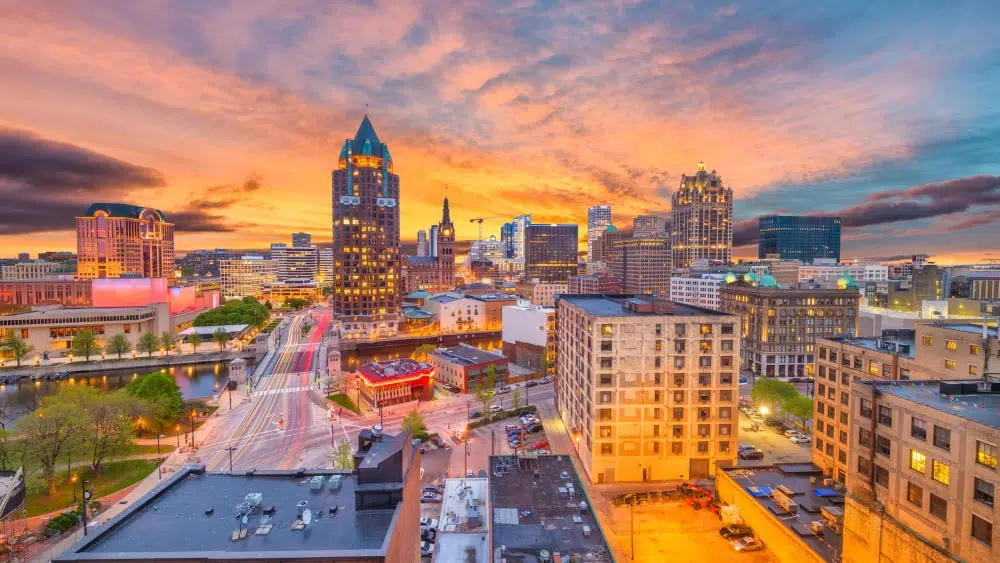
The great outdoors, hometown brews, and more cheese than you can imagine — what more could you want? Wisconsin has it all, from warm, sunny summers to beautiful, snowy winters. The state has many great places to live that are perfect for all walks of life, so it can be hard to decide which one is the best fit for you and fits your price range. Here, NewHomeSource offers its list of the 10 best places to live in Wisconsin.
1. Wausau
- Housing cost to income ratio: 2.23%
- Average childcare cost to income ratio: 1.12%
- Violent crime index: 15.1
- Nonviolent crime index: 32.5
- Cost of living index: 78.8
The name Wausau may mean “a faraway place,” but this town is located right in the center of Wisconsin. Wausau is located just east of the 45 x 90 geographical marker (45°N 90°W), which is exactly halfway between the equator and the North Pole, a quarter of the way around the planet from the prime meridian at Greenwich, England, and halfway between Greenwich and the International Date Line. Wausau is also known as “Arts Town, USA” for its dedication to arts and culture. Wausau is known for its beautiful setting near the Wisconsin River and its historic downtown area. The city’s central location in Wisconsin makes it a hub for business and recreation in the region.
Downtown has many art exhibits and museums, and you will always find a live show at the Grand Theater. Wausau receives an average of about 32 inches of rain, 56 inches of snow, and 186 sunny days per year, making it easy to find a day to enjoy any of Wausau’s outdoor activities. Residents enjoy fishing, kayaking, canoeing, camping, and water skiing on the Wisconsin River. Rib Mountain State Park provides more than five miles of trails for hiking and snowshoeing with scenic views. Marathon County has local parks to hike, bike, picnic, and view wildlife.
Wausau’s close-knit community, which leans conservative, is perfect for families of all ages. Aided by excellent schools and healthcare facilities, Wausau checks off your wants and needs list. Committed to academic excellence, Wausau School District is ready to serve your family. Northcentral Technical College and the University of Wisconsin-Marathon County are great options for higher education. Aspirus Wausau Hospital is ready to provide comprehensive medical services and specialized care.
There’s culture in Wausau. Visit Leigh Yawkey Woodson Art Museum, known internationally for its Birds in Art exhibition. The Grand Theater and Center for the Visual Arts are also central to Wausau’s cultural scene, offering a variety of performances and exhibitions. Celebrate with the community at the Wausau Festival of Arts and the Wisconsin Valley Fair.
With major employers in manufacturing, healthcare, insurance, and retail, residents appreciate the vibrant economy. The city’s economic development efforts focus on attracting and retaining businesses. Marathon Electric and Aspirus Health System are two large employers in the area.
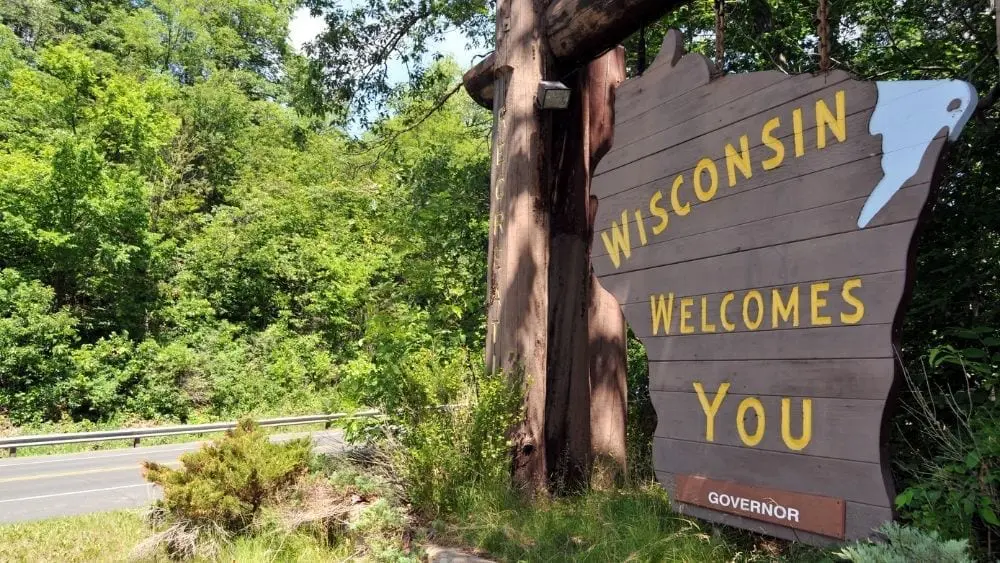
2. La Crosse
- Housing cost to income ratio: 2.93%
- Average childcare cost to income ratio: 1.51%
- Violent crime index: 12
- Nonviolent crime index: 52.5
- Cost of living index: 84.4
La Crosse is located on the banks of the Mississippi River and is the largest city on Wisconsin’s western border. A liberal community, it’s home to the University of Wisconsin–La Crosse and two other colleges. Nestled along the Mississippi River, La Crosse offers an appealing blend of natural beauty, vibrant community life, and a growing economy, making it an attractive location for new homebuyers. Known for its scenic riverfront, bluffs, and active downtown area, La Crosse provides a unique living experience that combines the tranquility of a smaller town with the amenities of a larger city.
The city also has amenities for residents of all ages, including excellent public and private schools and well-equipped hospitals. The area is served by the La Crosse School District, offering a range of educational programs and academic rigor. La Crosse is not only home to the University of Wisconsin-La Crosse but also Viterbo University and Western Technical College. All of these institutions contribute to the city’s vibrant educational and cultural scene.
La Crosse also has a wide range of live and local entertainment ranging from weekly comedy shows to the La Crosse Symphony Orchestra. Downtown offers a wide variety of restaurants with cuisines from all over the world, as well as a host of bars, as part of the Craft Beverage Trail that starts in La Crosse and takes participants all around the area and into Minnesota to enjoy wineries, breweries, and distilleries across the region. La Crosse is known for its high number of bars per capita and has a rich brewing history.
Discover a paradise for outdoor enthusiasts. Nearby Perrot State Park and Great River Bluffs State Park offer stunning scenic views and a variety of outdoor activities. Riverside Park, in the heart of La Crosse, provides beautiful riverfront views and is a popular spot for community gatherings and events. The region is known for its extensive network of biking and hiking trails, including the Great River State Trail. Community events are plentiful, with arts and music festivals, farmers’ markets, and cultural events throughout the year that bring the community together. Oktoberfest USA, one of the largest German festivals in North America, is a highlight, along with the Riverfest and the La Crosse Jazz Festival.
Find your share of culture at the Pump House Regional Arts Center. It is a hub for visual and performing arts. Learn more about the area at the La Crosse County Historical Society or take a stroll through the Dahl Auto Museum.
Major employers are found in the regional medical hub with facilities like Gundersen Health System and Mayo Clinic Health System as well as in the education and manufacturing fields. You will find excellent employment opportunities with Trane Technologies and the University of Wisconsin-La Crosse.
If you’re looking for an attractive Wisconsin locale, La Crosse, checks off a lot of boxes being a well-rounded and desirable place to live. Like being near the city but not in it? Check out the suburbs of Onalaska and Holmen.
3. Appleton-Oshkosh
- Housing cost to income ratio: 3.30%
- Average childcare cost to income ratio: 1.34%
- Violent crime index: 20.4
- Nonviolent crime index: 27.1
- Cost of living index: 84.9
Appleton and Oshkosh both sit on Lake Winnebago, just southwest of Green Bay. Together, these cities get about 32 inches of rain, 41 inches of snow, and 189 sunny days enjoying all four seasons. Lake access plays a big role in the summer for fishing and camping and in the winter for ice skating. This area is perfect for anyone looking for easy access to Green Bay without all the traffic and crowds. Though both cities are on the smaller side, the area is not lacking any big city amenities, like shops and restaurants. Together they have excellent hospitals that serve the entire area. Appleton is known for a number of firsts, including the first telephone in Wisconsin. Oshkosh is renowned for its historic lumber industry and the Oshkosh B’Gosh clothing brand.
Appleton’s downtown has more than 65 pubs and restaurants, including pet-friendly spaces, and their streets are lined with boutiques and specialty shops run by local vendors. Oshkosh hosts a (mostly) year-round farmers market where residents can buy locally sourced produce and handmade items. The market is held on a downtown city block during the summer and inside during the winter so residents can comfortably shop for their favorites. Oshkosh is also home to the Leach Amphitheater where residents can enjoy weekly live entertainment, both local and touring. The drive between Appleton and Oshkosh is short, about 30 minutes, but residents can also take advantage of the GO Transit transportation system in Oshkosh or the Valley Transit transportation system in Appleton.
Aviation buffs will appreciate the exhibits at the EAA Aviation Museum and the annual EAA AirVenture Oshkosh, the world’s largest airshow. Appleton insights are gained at the History Museum at the Castle. Discover exhibits on Harry Houdini, a famous magician. Waterfest in Oshkosh along with EAA AirVenture are some of the major events that draw visitors from across the nation and offer a wide range of entertainment and cultural experiences.
Appleton Area School District and Oshkosh Area School District, both known for their strong academic programs, serve the region. There are also private schooling options available including Lourdes Academy, Valley Christian School, and Xavier Catholic Schools. Higher education institutions include the University of Wisconsin-Oshkosh and Lawrence University in Appleton. Excellent medical facilities include ThedaCare Regional Medical Center-Appleton and Ascension NE Wisconsin – Mercy Campus in Oshkosh both offering comprehensive healthcare services.
The economy in Appleton-Oshkosh is diverse, with major employers including ThedaCare, Oshkosh Corporation, and Kimberly-Clark Corporation. The region’s economy is bolstered by a mix of manufacturing, healthcare, and education, contributing to its stability and growth.
Rich in opportunities for outdoor recreation, Lake Winnebago along with High Cliff State Park will have you making memories. Bike, hike, fish, and boat to your heart’s content. This region, part of the larger Fox Cities area, is known for its welcoming atmosphere, cultural richness, and economic stability. Prefer to live a little farther outside city limits? Take a look at the area’s top suburbs of Neenah, Kimberly, and Sherwood.
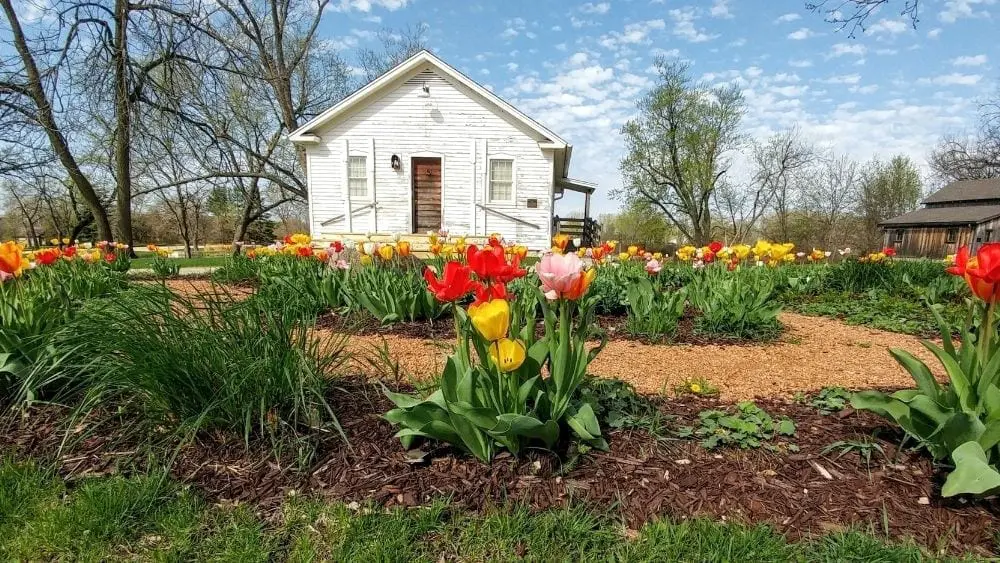
4. Janesville-Beloit
- Housing cost to income ratio: 3.42%
- Average childcare cost to income ratio: 1.37%
- Violent crime index: 19.3
- Nonviolent crime index: 43.7
- Cost of living index: 82.2
Check out a great location just 45 minutes south of the Wisconsin capital. The Janesville-Beloit area is a southern Wisconsin gem along the Rock River. The location of these two cities is also less than 2 hours from Milwaukee. Janesville is full of unique dining and shopping destinations as well as outdoor activities like fishing and golfing. Downtown Janesville is home to one of the oldest family-owned beverage companies in the nation, Gray Brewing Company, started in 1856. Beloit is located right on the Illinois border and is home to historical Wisconsin sites, including the storied Beloit College.
Janesville is known as “Wisconsin’s Park Place” due to its extensive park system. Beloit’s revitalization of its riverfront and downtown areas has been nationally recognized, showcasing the community’s commitment to sustainable development. The organization, Friends of RiverFront, brings in entertainment year-round for Beloit residents to Riverside Park, including live concerts, movie nights, and dance classes at Harry’s Place, an outdoor pavilion on the river. The area hosts several festivals throughout the year, celebrating everything from local culture to international cinema. Popular events include the Beloit International Film Festival and the Janesville Renaissance Faire.
Rich in cultural attractions, take full advantage of perks like the Janesville Performing Arts Center, the Wright Museum of Art in Beloit, and the Lincoln-Tallman House in Janesville. Delicious restaurants, shops, and services make this a well-established place to call home.
The Janesville-Beloit area gets about 185 sunny days per year. Janesville-Beloit experiences a continental climate with four distinct seasons. Summers are warm and conducive to outdoor activities, while winters are cold and snowy, ideal for winter sports enthusiasts. Spring and fall offer milder weather and beautiful seasonal changes, particularly in foliage.
From the Rock River, which offers boating and fishing, to extensive biking and hiking trails, there is plenty for nature lovers. The Rotary Botanical Gardens in Janesville are a highlight for both residents and visitors. Big Foot Beach State Park and the Kettle Moraine State Forest provide ample opportunities for hiking, camping, and nature exploration. Local parks, including Riverside Park in Janesville and Riverside Park in Beloit, offer scenic beauty and recreational activities. Your furry friends are able to enjoy dog-friendly parks and trails including the Paw Print Park in Janesville.
Key healthcare providers in the area include Mercyhealth Hospital and Trauma Center in Janesville and Beloit Memorial Hospital, ensuring residents have access to comprehensive medical care. Private schools as well as the Janesville School District and the School District of Beloit provide excellent academic offerings. Beloit College, a private liberal arts college, is known for its engaging curriculum and international focus.
The economy is strengthened by employment opportunities in the fields of manufacturing, healthcare, and education. A few of the major employers include Mercyhealth, School District of Janesville, and ABC Supply Co. in Beloit. The area’s economy has been steadily diversifying, and there is a focus on attracting new businesses and industries.
Janesville-Beloit offers a mix of small-town charm, community engagement, and access to natural beauty, making it an appealing choice for new homebuyers. The area’s affordable living, diverse educational opportunities, cultural richness, and growing economy make it a well-rounded and inviting place to live.
5. Eau Claire
- Housing cost to income ratio: 4.06%
- Average childcare cost to income ratio: 1.21%
- Violent crime index: 10
- Nonviolent crime index: 24.4
- Cost of living index: 96.4
Eau Claire is the principal city in the Chippewa Valley area of western Wisconsin. This city prides itself on its welcoming community and “indie” views. It is a liberal leaning community structured around hospitality, originality, creativity, and positive attitudes. Eau Claire is considered a college town as the University of Wisconsin–Eau Claire makes its home here. There is something for everyone in this inviting city.
Typically averaging around 33 inches of rain, 46 inches of snow, and 192 sunny days per year, Eau Claire is ideal for outdoor adventures all year long. Eau Claire is surrounded by parks for camping, hiking, and biking, and the Chippewa River is open for fishing, tubing, and swimming during the hotter months.
The city is a haven for outdoor enthusiasts, offering parks, hiking trails, and waterways. The Chippewa River State Trail is perfect for biking and walking, while Phoenix Park is a hub for community gatherings. Many residents make the short drive to nearby state parks for fun. Lake Wissota State Park and Brunet Island State Park offer camping, hiking, and boating opportunities. Enjoy a quick escape to nature and create long lasting memories.
Eau Claire is also a big fan of all things art. Residents will find new art lining the streets that make up the Sculpture Tour, and they can vote for their favorites to stay up year-round. The Children’s Museum of Eau Claire and the Chippewa Valley Museum offer a variety of exhibits. The city’s thriving arts scene is evident in its live music venues, art galleries, and the Eau Claire Regional Arts Center. Famous for its music and arts festivals, including the Eau Claire Jazz Festival and the Blue Ox Music Festival, you will find a cultural calendar that attracts visitors from all over.
Besides the university, Eau Claire also has experienced schools so families will have no problems finding the right fit for their educational needs. Private school options with religious affiliations are other options. Strong academics and extracurricular offerings give you peace of mind. Chippewa Valley Technical College contributes to the community as well.
Reputable healthcare facilities improve the economy and provide comprehensive healthcare. The Mayo Clinic Health System, HSHS Sacred Heart Hospital, and the University of Wisconsin-Eau Claire are among the top employers.
Eau Claire has been recognized as a city on the rise, particularly for its music and arts scene. The city’s redevelopment efforts, especially in the downtown area, have been widely praised. New home communities in Eau Claire provide a compelling mix of natural beauty, cultural richness, educational opportunities, and a strong sense of community. Let Eau Claire be the backdrop for a balanced and fulfilling lifestyle.
6. Fond du Lac
- Housing cost to income ratio: 4.07%
- Average childcare cost to income ratio: 1.72%
- Violent crime index: 10.6
- Nonviolent crime index: 16.5
- Cost of living index: 98
Fond du Lac is the county seat of Fond du Lac County. Fond du Lac means “bottom of the lake” in French. This city is somewhat conservative, and the community is built on its small-town charm and love of the great outdoors. Nestled at the southern tip of Lake Winnebago, the city combines the serenity of a lakeside community with the convenience of urban living.
Fond du Lac averages 33 inches of rain, 43 inches of snow, and about 188 sunny days annually, perfect conditions for taking advantage of the proximity to Lake Winnebago. In the summer, there is fishing, camping, and hunting, and in the winter, there is ice fishing and snow skiing. The city is filled with beautiful scenery that was made possible by the community’s successful efforts to have Fond du Lac recognized as a Tree City by the Arbor Day Foundation. There are parks in and around Fond du Lac, such as Lakeside Park, which offers a picturesque setting for various recreational activities. The nearby Kettle Moraine State Forest allows for hiking, biking, and camping opportunities.
Several museums and cultural attractions will keep you entertained. Make visits to the Fond du Lac Children’s Museum and the Galloway House and Village. These spots offer educational and cultural experiences while highlighting local history and intriguing exhibits.
Discover professional and caring staff at the Fond du Lac School District. You can also choose from private schools including F A C E S St. Patrick Campus and Redeemer Lutheran School. Moraine Park Technical College and Marian University are located in Fond du Lac. Comprehensive medical care is found at St. Agnes Hospital.
A strong sense of community at local events includes the Fond du Lac County Fair showcasing the area’s agricultural heritage. Another fun event is Walleye Weekend. This family-focused festival is centered around a fishing tournament.
Career paths are created amongst the many employers in the area. With a strong showing in healthcare, manufacturing, and education, major employers in the area include Mercury Marine and Agnesian Healthcare.
Fond du Lac presents an appealing mix for those looking to establish roots in a dynamic yet serene environment. With inviting new home communities in the area, you can find the new home of your dreams with the amenities, features, and finishes you crave.
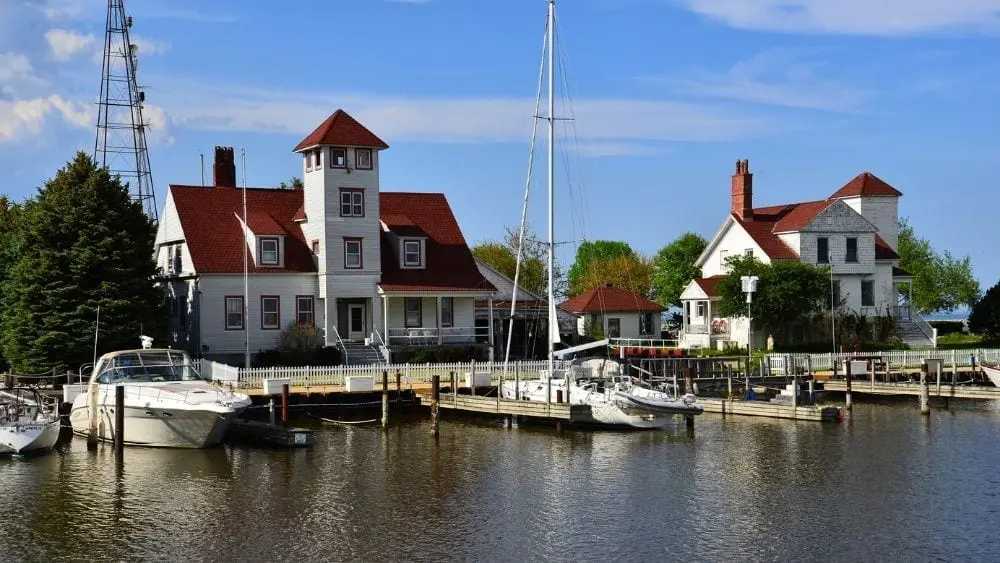
7. Racine
- Housing cost to income ratio: 3.28%
- Average childcare cost to income ratio: 2.38%
- Violent crime index: 23.9
- Nonviolent crime index: 45.2
- Cost of living index: 79.4
Racine sits on the shore of Lake Michigan in southeastern Wisconsin, about 25 miles from Milwaukee. This city is full of great outdoor activities, shopping, dining experiences, and family-friendly adventures. Downtown has a unique blend of local and international influence with the mix of ethnic cuisines, art shows, and boutiques. Some of this influence can be seen in the Quilts on Barns art project that spreads throughout Racine County.
Racine also celebrates its rich industrial history through tours that highlight the headquarters of companies like S.C. Johnson & Son (Frank Lloyd Wright designed the main administration building). Racine’s economy historically centered around manufacturing, and it continues to be a significant sector. InSinkErator is headquartered here. The city is also seeing growth in healthcare, education, and service industries.
With an average climate of 187 sunny days per year, it is easy to find a nice day to explore the city. Racine appeals to all ages with its excellent schools and healthcare. Racine Unified School District serves the area, offering a range of educational programs and services. Private schools providing rich educational options include the Prairie School and Hope Christian School – Via. The city is served by Ascension All Saints Hospital and other medical facilities, providing comprehensive healthcare services to residents.
The city’s location on Lake Michigan provides ample opportunities for water-related activities such as boating, fishing, and swimming. Racine’s North Beach is known for its sandy shores and is a popular summer destination. The city parks and trails are ideal for hiking, biking, and outdoor exploration, including the scenic Racine County Bike Trail. Nearby Richard Bong State Recreation Area offers additional outdoor activities including camping, hiking, and wildlife observation.
From delicious restaurants to excellent shopping, Racine is the complete package. Racine hosts numerous festivals and events throughout the year, celebrating its diverse community and rich cultural heritage. These include the popular Racine Fourth Fest, one of the Midwest’s largest Fourth of July parades and celebrations, and various cultural festivals reflecting the city’s ethnic diversity.
Racine is known as the “Invention City” due to its history of innovation, including being the birthplace of the garbage disposal. If you prefer being away from the city center, you can also consider popular suburbs like Wind Point, Burlington, and Browns Lake.
8. Green Bay
- Housing cost to income ratio: 3.60%
- Average childcare cost to income ratio: 1.58%
- Violent crime index: 28.8
- Nonviolent crime index: 33.6
- Cost of living index: 82.3
One of Wisconsin’s most famous cities, Green Bay has more to offer than being a destination on a football fan’s bucket list. Green Bay sits on the path of the Niagara Escarpment, a long cliff line that runs through several northern states and into Canada. This makes the landscape in Green Bay unique and exciting to explore. Green Bay, often known as the “Toilet Paper Capital of the World” due to its notable paper industry, presents a unique mix of historical charm, sports enthusiasm, and natural beauty, making it a special place for new homebuyers.
There are also plenty of water activities, like fishing and skiing, available on Lake Michigan, Fox River, and of course, the “Bay of Green Bay.” All of this outdoor adventure is achievable because of Green Bay’s yearly average climate of 30 inches of rain, 48 inches of snow, and 187 days of sunshine. The city’s location near Lake Michigan influences its weather bringing cooler temps in the summer and moderating the cold in the winter.
Rest easy knowing there are excellent schools in the area including Green Bay Area Public School District, Notre Dame Academy, and Providence Academy. The University of Wisconsin-Green Bay is fast growing with a variety of undergraduate degrees. Medical services are provided by Bellin Hospital and St. Vincent Hospital.
Sports fans love supporting the Green Bay Packers. Cheeseheads don their green fan gear. They come by this name as Wisconsin produces over 25% of the country’s cheese. Looking for other fun? The city is known for its beautiful parks like Bay Beach Amusement Park and the Green Bay Botanical Garden. Being close to Lake Michigan and the Fox River provides opportunities for fishing, boating, and watersports.
Attend one of the many festivals including Artstreet, a major arts festival, and the Oneida Pow-Wow, showcasing Native American culture. Go to the farmers’ markets or the inviting parks. Peninsula State Park and High Cliff State Park are nearby for camping, hiking, and stunning views of Lake Michigan. The Neville Public Museum, the Green Bay Packers Hall of Fame, and the National Railroad Museum have exhibits appealing to the interests of residents and tourists.
A diversified economy is assisted by major employers like Bellin Health, Schneider National, and Georgia-Pacific. Many employment sectors are represented including paper production, healthcare, food processing, and manufacturing.
Live in the oldest city in the state with the third-oldest franchise in the NFL. This is the only major league sports team that is community owned. Buy a new home in this area where you can see what all the fuss is about. Choose from the Green Bay new home communities to begin your path to an enhanced life in Wisconsin.
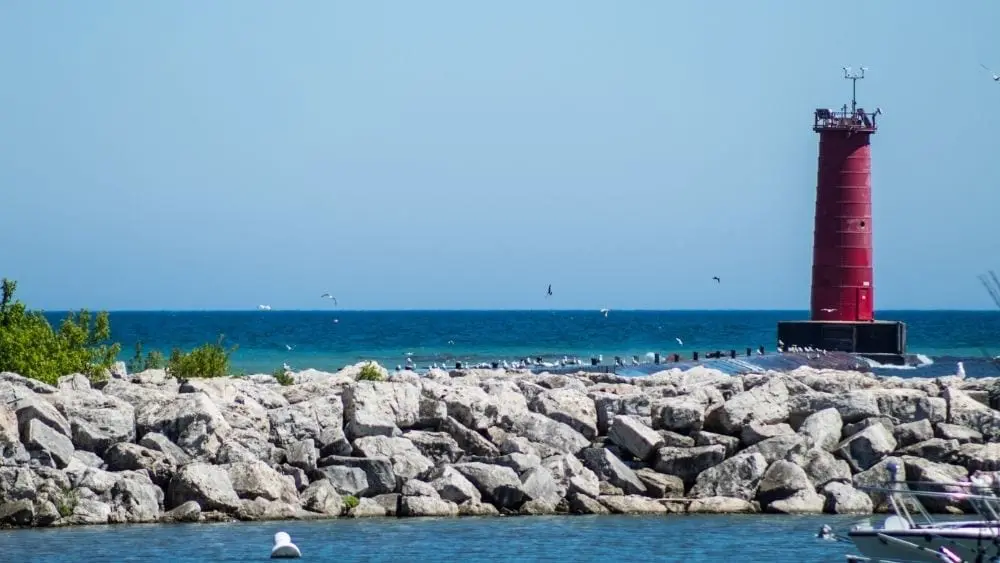
9. Ozaukee-Sheboygan
- Housing cost to income ratio: 4.54%
- Average childcare cost to income ratio: 1.02%
- Violent crime index: 6.7
- Nonviolent crime index: 18.6
- Cost of living index: 109.9
Ozaukee and Sheboygan are neighboring counties in east Wisconsin along Lake Michigan. Cities in these counties include Cedarburg, Port Washington, Sheboygan, and Sheboygan Falls. This area gets about 34 inches of rain, 44 inches of snow, and 190 sunny days per year, giving these counties the perfect weather to explore the beautiful scenery that surrounds them.
Ozaukee County has more than 10 parks, two golf courses, and multiple options for lake access. Sheboygan County has miles of natural biking trails and over 20 miles of paved trails and bike lanes and parks with picnic areas, campgrounds, and fishing piers. The best way to explore these two counties is to traverse the Interurban Trail, which runs through Ozaukee County into Sheboygan. Sheboygan’s nickname, “The Malibu of the Midwest,” speaks to its reputation as a top destination for freshwater surfing. Fishing, boating, and beach activities are popular along the Lake Michigan shoreline. Dunes, beaches, and forested areas provide a natural escape at Kohler-Andrae State Park. Your pet can join in on the outdoor adventures at Sheboygan Dog Park and Harrington Beach State Park.
The cities in this area are somewhat conservative politically and take pride in their rural charm. Families looking to relocate will be happy to find excellent school districts in the area with primary, intermediate, and secondary campuses. Private school options include parochial and independent schools. Higher education options include Lakeshore Technical College and Concordia University Wisconsin.
Check out the food and fun at Sheboygan Brat Days and Cedarburg Strawberry Festival. Dine at some delicious restaurants offering everything from local comfort food to upscale steaks. Sheboygan is known for its bratwursts and is often referred to as the “Bratwurst Capital of the World.”
Manufacturing, healthcare, and education represent some of the larger employment fields in this region. Kohler Co., Sargento, and Johnsonville Sausage are significant contributors to the local economy.
10. Milwaukee-Waukesha
- Housing cost to income ratio: 3.37%
- Average childcare cost to income ratio: 1.85%
- Violent crime index: 73.1
- Nonviolent crime index: 59.5
- Cost of living index: 84.7
Four counties make up the bustling Milwaukee metropolitan area, the two biggest being Milwaukee County and Waukesha County. This beautiful area is ideal for those loving city services, natural beauty, and a strong economy. These counties are strongly liberal, anchored by Milwaukee, the largest city in the state. Surrounding communities are growing fast, especially suburbs such as Fox Point, Whitefish, and Elm Grove. Milwaukee has several monikers including the “City of Festivals” and “Brew City.” It is the birthplace of Harley-Davidson. Waukesha is known for its natural springs and has been called “Spring City.” Waukesha was once a famous resort due to these springs.
This area gets about 35 inches of rain, 45 inches of snow, and 190 sunny days per year, which makes for distinct seasons. It is perfect weather for fishing and boating on Lake Michigan or the Milwaukee River, enjoying any of the hundreds of public parks, walking miles of hiking trails, or taking your four-legged friend out to the many dog parks including Estabrook Park Dog Park. Milwaukee offers access to Lake Michigan with beaches and waterfront activities. Bike and walk the Hank Aaron State Trail and Oak Leaf Trail. Hiking, skiing, and wildlife observation are popular activities at nearby state parks like Lapham Peak State Park. The Milwaukee County Zoo is a great spot to make family memories.
Families looking for educational opportunities for their kids can find all levels of education in the school districts in the area including the largest in the state, Milwaukee Public Schools. Waukesha’s school district checks off academic and extracurricular programs. Marquette University and the University of Wisconsin-Milwaukee make their home in this region as well. Find quality healthcare in the region. Prominent hospitals include Froedtert Hospital, the Medical College of Wisconsin, and ProHealth Waukesha Memorial Hospital.
Local explorations will keep you busy. Visit the Milwaukee Art Museum, the Milwaukee Public Museum, and the Waukesha Count Historical Society and Museum. Diverse entertainment options are available at Pabst Theater and the Marcus Performing Arts Center. It goes without saying that Summerfest, the world’s largest music festival, brings excellent performances. Ethnic and cultural celebrations include the Polish Fest and Festa Italiana. Residents flock to the Waukesha BluesFest and the Waukesha JanBoree.
Major employers found in the manufacturing, healthcare, education, and financial services industries add to the economy here with career opportunities. Johnson Controls, GE Healthcare, and Aurora Healthcare are just a few of the major employers along with several small businesses. Top of Form
Enjoy life in a welcoming metropolitan area where new home communities enhance your quality of life with great locations and amenities.
This list was compiled using statistics for cost of living, average housing costs, average childcare costs, and crime indices.

Jessi Gonzalez writes on the topics of home-buying, home decor, and home-ownership for New Home Source. She has a degree from Coastal Bend College and is currently enrolled in the English degree program at Texas A&M Corpus Christi.
 Your Guide to Getting a Construction Loan
Your Guide to Getting a Construction Loan
Becky Olson
Hi!
Does your city have a good availability for affordable housing and do you have alot of social activites in your city
Hi!
Does your city have a good availability for low income housing and do you have have alot of black people in your city? I am white! I am looking for structured social activities for a senior citizen. And I am looking for flee markets in your city or near by.